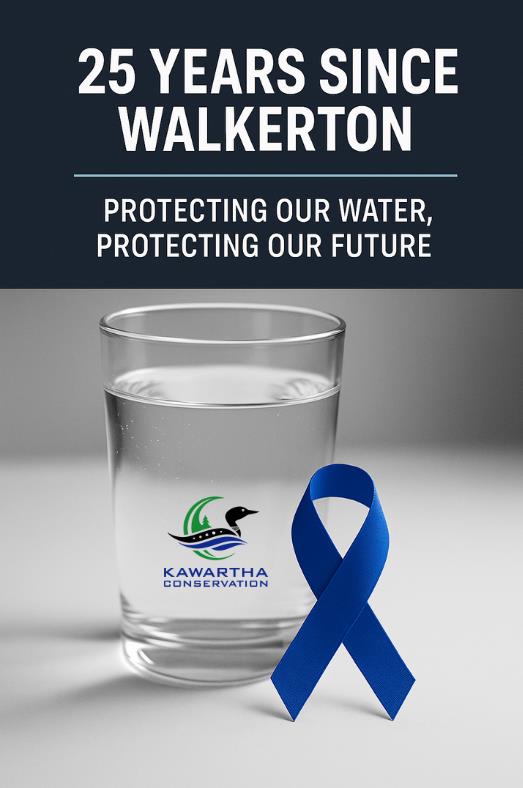25 Years Later: Protecting Our Drinking Water at the Source
 Twenty-five years ago, the small town of Walkerton, Ontario became the centre of one of Canada’s worst public health tragedies. In May 2000, E. coli contamination in the municipal drinking water system claimed the lives of seven people and made more than 2,000 others ill.
Twenty-five years ago, the small town of Walkerton, Ontario became the centre of one of Canada’s worst public health tragedies. In May 2000, E. coli contamination in the municipal drinking water system claimed the lives of seven people and made more than 2,000 others ill.
The cause? Contaminated well water that was neither adequately treated nor properly monitored. The aftermath? A sweeping overhaul of Ontario’s drinking water safety legislation and the birth of the province’s Source Water Protection framework - a proactive approach to ensuring clean, safe drinking water for generations to come.
In the years since the Walkerton tragedy, Ontario introduced the Clean Water Act, and with it, the development of Source Protection Plans across the province. These plans identify threats to municipal drinking water sources and outline policies to reduce or eliminate those threats - a shift from reactive to preventive water management.
At Kawartha Conservation, Source Water Protection isn’t just a policy - it’s a daily responsibility.
“We work with municipalities, agricultural producers, businesses, and homeowners to reduce risks to drinking water right at the source,” says Sarah Lavoie-Bernstein, Risk Management Official and Source Protection Technician at Kawartha Conservation. “Whether it’s ensuring proper fuel storage, safe handling of road salt, or implementing best management practices for farmers using fertilizers or pesticides invulnerable areas, each action makes a difference.”
Drinking water sources include rivers, lakes, and groundwater wells. These sources are vulnerable to contaminants like fuel, fertilizers, chemicals, and pathogens - particularly in Intake Protection Zones and Wellhead Protection Areas, where water is drawn for public use.
Through its work with the Trent Source Protection Coalition - which includes five Conservation Authorities across a large portion of south-central Ontario - Kawartha Conservation helps implement the Trent and Ganaraska Source Protection Plan. This plan lays out science-based policies tailored to local conditions and land uses, ensuring communities have safe, clean water both now and in the future.
“Our team conducts property visits, reviews land uses, and supports landowners through risk management strategies,” says Lavoie-Bernstein. “Most of the time, people want to do the right thing - they just need help understanding what that is.”
Source Water Protection is a collaborative process. Risk Management Officials like Lavoie-Bernstein provide guidance to property owners and municipalities within vulnerable zones - helping implement safeguards such as improving and implementing best management strategies for agricultural practices or adjusting storage and handling of materials near drinking water sources.
Education also plays a key role. “We spend a lot of time building relationships and having conversations about what’s underground, what’s nearby, and how it all connects to the water coming out of the tap,” she adds.
In fact, many residents are surprised to learn that what happens on land - even kilometres away - can directly affect the quality of their drinking water.
For many newer residents or younger families, Walkerton is a name they may not recognize. But the legacy of that event remains a central reason why Ontario’s drinking water is among the safest in the world today.
“The system established in response to the tragedy of Walkerton is well-designed to catch risks before they lead to devastation,” says Lavoie-Bernstein, “It is an effective policy that facilitates respect for our sources of water. I am grateful to be a part of this essential program.”
Source Water Protection may not always make headlines, but it’s one of the most effective tools we have to protect public health, the environment, and future generations.
Want to know if you live in a vulnerable area or how you can help protect drinking water sources in your community? Visit www.kawarthaconservation.com/sourcewater and click on Source Water Protection for maps, resources, and more information. You can also contact Sarah about any Source Water Protection questions by email at SlavoieBernstein@KawarthaConservation.com.
Contact Us
Kawartha Conservation
277 Kenrei Road
Lindsay, ON K9V 4R1
Tel: 705.328.2271
Fax: 705.328.2286
Subscribe to Receive Updates and Notifications
Stay up to date on flood and low water, news, activities, events, programs and operations by subscribing to updates and the Watershed Watch Newsletter.
